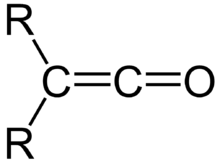Ketene

A ketene is an organic compound of the form R′R″C=C=O. Ketene also refers to the specific compound CH2=C=O, the simplest ketene molecule, which is occasionally called ethenone. Although they are highly useful, most ketenes are unstable, so they are not usually isolated during a reaction process.[1]
Preparation
Ketenes were first studied as a class by Hermann Staudinger.[2]
Ketene, the simplest ketene, is produced on a large scale industrially for use in the production of acetic anhydride. It can also be generated by pyrolysis (thermal cracking) of acetone:[3]
- CH3−CO−CH3 → CH2=C=O + CH4
This reaction is called the Schmidlin ketene synthesis.[4][5]
Ketenes can be prepared from acyl chlorides by an elimination reaction in which HCl is lost:
In this reaction, a base, usually triethylamine, removes the acidic proton alpha to the carbonyl group, inducing the formation of the carbon-carbon double bond and the loss of a chloride ion.
Ketenes can also be formed from α-diazoketones by Wolff rearrangement.
Another way to generate ketenes is through flash vacuum thermolysis (FVT) with 2-pyridylamines. Plüg and Wentrup developed a method in 1997 that improved on FVT reactions to produce ketenes with a stable FVT that is moisture insensitive, using mild conditions (480 °C). The N-pyridylamines are prepared via a condensation with R-malonates with N-amino(pyridene) and DCC as the solvent.[6]
Reactions and applications
Ketenes are generally very reactive, and participate in various cycloadditions. One important process is the dimerization to give propiolactones. A specific example is the dimerization of the ketene of stearic acid to afford alkyl ketene dimers, which are widely used in the paper industry.[7] AKD's react with the hydroxyl groups on the celluose via esterification reaction.
They will also undergo [2+2] cycloaddition reactions with electron-rich alkynes to form cyclobutenones, or carbonyl groups to form beta-lactones. With imines beta-lactams are formed. This is the Staudinger synthesis, a facile route to this important class of compounds. With acetone, ketene reacts to give Isopropenyl acetate.[1]
A variety of hydroxylic compounds can add as nucleophiles, forming either enol or ester products. As examples, a water molecule easily adds to ketene to give 1,1-dihydroxyethene and acetic anhydride is produced by the reaction of acetic acid with ketene. Reactions between diols (HO−R−OH) and bis-ketenes (O=C=CH−R′−CH=C=O) yield polyesters with a repeat unit of (−O−R−O−CO−R′−CO).
Ethyl acetoacetate, an important starting material in organic synthesis, can be prepared using a diketene in reaction with ethanol. They directly form ethyl acetoacetate, and the yield is high when carried out under controlled circumstances; this method is therefore used industrially.
See also
References
- 1 2 Raimund Miller, Claudio Abaecherli, Adel Said, Barry Jackson "Ketenes" in Ullmann's Encyclopedia of Industrial Chemistry, 2001, Wiley-VCH, Weinheim. doi: 10.1002/14356007.a15_063
- ↑ Hermann Staudinger (1905). "Ketene, eine neue Körperklasse" [Ketenes, a new class of substances]. Berichte der deutschen chemischen Gesellschaft. 38 (2): 1735–1739. doi:10.1002/cber.19050380283.
- ↑ Weygand, Conrad (1972). Hilgetag, G.; Martini, A., eds. Weygand/Hilgetag Preparative Organic Chemistry (4th ed.). New York: John Wiley & Sons, Inc. pp. 1031–1032. ISBN 0471937495.
- ↑ Ketene in Organic Syntheses Organic Syntheses, Submitted by C. D. Hurd Checked by Oliver Kamm Coll. Vol. 1, p.330 (1941); Vol. 4, p.39 (1925). Link
- ↑ Julius Schmidlin and Maximilian Bergman (1910) "Darstellung des Ketens aus Aceton" (Preparation of ketene from acetone), Berichte der deutschen chemischen Gesellschaft, 43 (3) : 2821-2823.
- ↑ Carsten Plüg ,Hussein Kanaani and Curt Wentrup (12 February 2015). "Ketenes from N-(2-Pyridyl)amides". CSIRO Publishing. Retrieved 21 February 2018.
- ↑ Raimund Miller, Claudio Abaecherli, Adel Said, Barry Jackson "Ketenes" in Ullmann's Encyclopedia of Industrial Chemistry, 2001, Wiley-VCH, Weinheim. doi: 10.1002/14356007.a15_063

